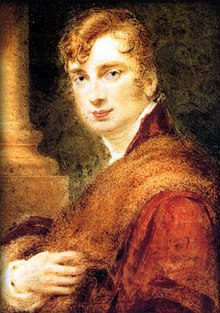William John Bankes
|
William John Bankes FRS |
|
|---|---|

Portrait by George Sandars, 1812
|
|
| Member of Parliament for Truro |
|
|
In office 1810–1810 |
|
| Preceded by | Charles Powlett, 2nd Baron Bayning |
| Succeeded by | Sir George Warrender, 4th Baronet |
| Member of Parliament for Cambridge University |
|
|
In office 1822–1826 |
|
| Preceded by | John Henry Smyth |
| Succeeded by | John Copley, 1st Baron Lyndhurst |
| Member of Parliament for Marlborough |
|
|
In office 1829–1832 |
|
| Preceded by | James Brudenell, 7th Earl of Cardigan |
| Succeeded by | Henry Bingham Baring |
| Member of Parliament for Dorset |
|
|
In office 1832–1835 |
|
| Preceded by | Edward Portman, 1st Viscount Portman |
| Succeeded by | Anthony Ashley-Cooper, 7th Earl of Shaftesbury |
| Personal details | |
| Born | 11 December 1786 |
| Died | 15 April 1855 (aged 68) |
| Nationality | British |
| Political party | Tory |
| Relations | Henry Banks(father), Frances Woodley (mother) |
| Alma mater | Trinity College, Cambridge |
| Occupation | Explorer, egyptologist and adventurer |
| Military service | |
| Allegiance | United Kingdom |
| Service/branch | British Army |
| Rank | aide-de-camp |
William John Bankes (11 December 1786 – 15 April 1855), the second, but first surviving son of Henry Bankes, was a notable explorer, Egyptologist and adventurer. He was a member of the Bankes family of Dorset and he had Sir Charles Barry recase Kingston Lacy in stone as it is today. He travelled extensively to the Near East and Egypt and made an extensive individual collection of Egyptian artefacts. His work on Egypt although not acknowledged until recently is vastly important. He was a good friend of Lord Byron, Samuel Rogers and Sir Charles Barry. He also served as Tory Member of Parliament (MP) for Truro in 1810, for Cambridge University from 1822 to 1826, for Marlborough (the UK parliamentary constituency that his maternal grandfather, William Woodley, for whom he was named, had held from 1780 to 1784) from 1829 to 1832 and finally for Dorset from 1832 to 1835.
William Bankes became interested with exploration and discovery and had an evident passion for ancient Egypt and fine art. His massive portfolio of notes, manuscripts and drawings produced and collected during his travels along the Nile with explorations in Egypt, Nubia, and the Near East with Giovanni Finati, whose memoirs he translated, have significant historical value and provide the only historical record of some inscriptions and monuments. He published his Travels in the East
Bankes was an educated and affluent man, though at times somewhat mischievous and boisterous. He was born in 1786 to Frances Woodley (b. 1760 d. 1823) and Henry Bankes, MP, of Kingston Lacy and Corfe Castle in Dorset. Frances was the eldest daughter of William Woodley (MP for Great Bedwin and Marlborough), Governor and Captain-General of the Leeward Islands (1766–1771 and 1791–1793), and his wife Frances Payne of St Kitts. William's aunt was Maria Banks (Woodley) Riddell, a well-known poet, who was known to be the chief benefactor of the Scottish poet Robert Burns. William's sister, Anne Francis Bankes married Edward Boscawen, 1st Earl of Falmouth in 1810. In 1841, on the death of her husband, Lady Falmouth returned to reside at Kingston Lacey. It was Lady Falmouth, in the absence of her brother, who was responsible for the ongoing re-decoration of Kingston Lacy which had been commenced by her mother Francis (Woodley) Bankes.
...
Wikipedia
